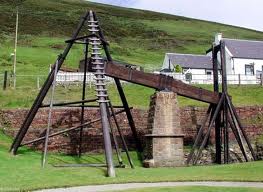Heritage Buildings and Sites - Wanlockhead

Beam Engine
This pumping engine, on Straitsteps Mine, is the last remaining water bucket engine to be seen on a mine in Europe.
It is now owned and maintained by Historic Scotland.
The beam is made up of two baulks of pitch wood and is 7.4m long, 61cm deep and 28cm wide.
Wrought iron straps bind the two baulks together and at the centre and ends are carved reinforcing pads.
The beam is mounted on a pillar of dressed freestone 4.3m high and 2.1m x 91cm at the base.
The beam pivoted on a trunnion of ingenious design by which a massive wrought iron axle is jointed to a cast iron support under the beam centre.
The axle turns in step Plummer blocks on brass bearings and is anchored in the pillar by long tie rods which pass through the pillar and are secured at the base.
At the power end, the cross-head guiding the rod to which the bucket was attached moved inside a high wooden 'steeple'.
The bucket rod, fixed to the 'steeple' is 3.6m long and had a 23cm diameter plate at the bottom which supported the bucket.
The stone-lined pit into which the bucket descended is 1.8m deep and in the bottom is a drainage outlet through which the water, when emptied from the bucket, flowed into the nearby burn.
The beam engine allowed miners to continue working in the Straitsteps mine.
There were two strokes of the beam per minute and would lift around 7280 litres of water from up to 28 metres below ground per hour.
Periodically the weight of the piston was adjusted so that it remained heavier than the empty bucket, ensuring that the beam fell to start the cycle again.
Requiring little attention it would have been left to work twenty-four hours a day.

William Symington
William Symington (1764-1831) was an engineer and inventor, and the builder of the first practical steamboat.
Symington was born in Leadhills, to a family he described as being "respectable but not wealthy." His father worked as a practical mechanic at the Leadhills mines.
Although his parents intended for him to enter the ministry, he intended to use his good education to make a career as an engineer.
In 1785 he joined his brother George in his attempts to build a steam engine at Wanlockhead.
He impressed the manager of the mining company, Gilbert Meason, so much that he was sent to the University of Edinburgh in 1786 to spend a few months attending science lectures.
By the time William joined his brother, George had already succeeded in building the second engine using James Watt's design to be built in Scotland.
William Symington quickly saw a way to marry the efficiency of the Watt engine with the simplicity of that devised by Thomas Newcomen.
Encouraged by Gilbert Meason, Symington demonstrated the practicality of his idea and his improved atmospheric engine was patented in 1787.
When Watt sent someone to make a sketch of how this new engine worked, he discovered that the steam was condensed under a second piston and this was then pushed down when fresh steam entered the cylinder, forcing out the condensate. The power piston worked by the atmospheric pressure acting on the vacuum created by the condensing steam.
After its completion, Symington drew up a prospectus outlining the advantages of his invention, and this was circulated by Meason and his influential friends.
This resulted in the improved engine at Bay Mine in 1789 and Symington becoming known as the inventor of the commercially viable atmospheric pumping engine.

Bay (Charles) Mine
The Bay vein was worked from a mine in a little valley to the North-East of the Wanlock Burn called Whyte's Cleuch. It is bordered by the Dod Hill and Limpen Rig and is about 900m long. Many of the ore veins cross the valley and it has always been an important centre of mining operations.
Bay mine was named after Botany Bay in Australia.
1789 saw the opening of the pumping main shaft at Bay Mine.
Two shafts, one for pumping and one for winding, reach the adit, known as Milligan's Level, about 33m below the surface.
Although rainfall is high the valley has not got sufficient catchment area at its head to provide a constant flow of water in the streams. This insufficiency of water for driving the pumping machinery was exacerbated by geological conditions which allowed the surface water to flow down faults and crush zones into the mine workings.
The pumping problems which dogged successive mining companies were summed up in a report on the Wanlockhead mines in the eighteenth century when the agent wrote:
"The workings must always be precarious and uncertain because with the great rains and snows in the winter time, so swell the springs that the engines cannot manage them, while in the summer season the water is so scanty it is not enough to turn the wheels".
It was a situation which greatly hindered profitable operations and one which made reliable and economic pumping the key to their realisation.
This mine is famed for being the site of William Symington's Improved Atmospheric Pumping Engine
Evidence of the veins and their minerals may be found in the spoil heaps. The following have been recorded:
Galena, Zinc, Calcite, Barytes, Ankerite, Haematite, Linarite, Vanadite, Smithsonite, Malachite, Azurite, Pyromorphite, Cerusite, Leadhillite, Anglesite.
The Bay Mine closed in 1919
